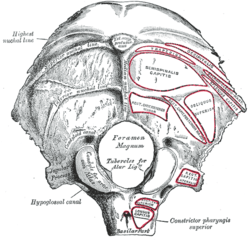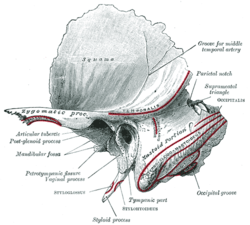Longus capitis muscle
The longus capitis muscle (Latin for long muscle of the head, alternatively rectus capitis anticus major), is broad and thick above, narrow below, and arises by four tendinous slips, from the anterior tubercles of the transverse processes of the third, fourth, fifth, and sixth cervical vertebræ, and ascends, converging toward its fellow of the opposite side, to be inserted into the inferior surface of the basilar part of the occipital bone.
| Longus capitis muscle | |
|---|---|
 The anterior vertebral muscles. | |
| Details | |
| Origin | anterior tubercles of the transverse processes of the third, fourth, fifth, and sixth cervical vertebræ |
| Insertion | basilar part of the occipital bone |
| Nerve | C1-C3/C4 |
| Actions | flexion of neck at atlanto-occipital joint |
| Identifiers | |
| Latin | musculus longus capitis |
| TA | A04.2.01.003 |
| FMA | 46308 |
| Anatomical terms of muscle | |
It is innervated by a branch of cervical plexus.
Longus capitis has several actions:
acting unilaterally, to:
- flex the head and neck laterally
- rotate the head ipsilaterally
acting bilaterally:
- flex the head and neck[1]
Additional images
 Occipital bone. Outer surface.
Occipital bone. Outer surface. Left temporal bone. Outer surface.
Left temporal bone. Outer surface. Base of skull. Inferior surface.
Base of skull. Inferior surface.- Longus capitis muscle
- Longus capitis muscle
References
This article incorporates text in the public domain from page 395 of the 20th edition of Gray's Anatomy (1918)
External links
- "Anatomy diagram: 25420.000-1". Roche Lexicon - illustrated navigator. Elsevier. Archived from the original on 2014-01-01.
- PTCentral
This article is issued from
Wikipedia.
The text is licensed under Creative
Commons - Attribution - Sharealike.
Additional terms may apply for the media files.